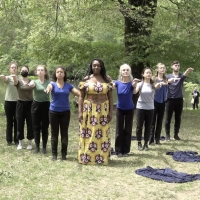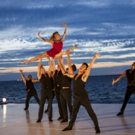Beth Jucovy's DANCE VISIONS NY Comes to TADA This Weekend
by Stephi Wild - Mar 22, 2022
Beth Jucovy's 'Morning Afternoon Evening,' a holistic artwork encompassing dance, theater and music and background film, brings to life the imagery and ideas expressed in a lyrical and symbolic poem written by the creator's daughter Kyra Jucovy. Part of the Emerging Artists Theatre's New Work Series at the TADA Theater, 15 West 28th Street, NYC.
THE LAND ON WHICH WE DANCE, GALLIM, And More Announced At Jacob's Pillow, August 7-11
by A.A. Cristi - Jul 23, 2019
Gallim makes its Ted Shawn Theatre debut with a Pillow co-commissioned world premiere, August 7-11. Under the direction of perpetually groundbreaking artist Andrea Miller, Brooklyn-based Gallim embodies human connection through bold, raw, transformative works. As New York Magazine attests, a?oeher viscerally physical movement wrings every inch of life from her dancersa?"and you'll be holding your breath, too.a??
May Events Announced At Green Space
by A.A. Cristi - Apr 16, 2019
Green Space is pleased to announce a diverse roster of artists for its signature programs this May. Take Root will present an evening of work by Edgar Cortes Dance Theater and Dance Visions NY on May 17th and 18th, and Fertile Ground showcases works-in-progress by multiple dance artists on May 19th.
New York City Ballet's Sara Mearns to Perform with PTAMD at Lincoln Center
by BWW News Desk - Aug 23, 2017
Paul Taylor has invited New York City Ballet Principal Dancer Sara Mearns to perform works by Isadora Duncan reconstructed by The Isadora Duncan Dance Company Artistic Director, Lori Bellilove during the 2018 Season of Paul Taylor American Modern Dance (PTAMD) at the David H. Koch Theater at Lincoln Center.
Jacob's Pillow Launches New Online Dance Resource
by Gabrielle Sierra - Mar 28, 2011
Jacob's Pillow Dance Festival, National Historic Landmark and recent recipient of a 2010 National Medal of Arts, today launches Jacob's Pillow Dance Interactive, an online video collection of dance highlights from 1937 through 2010.
Tulsa PAC Closes THE SCARLET LETTER, 1/22
by BWW News Desk - Jan 22, 2011
Phyllis Nagy's play, The Scarlet Letter, has the words 'adapted from the novel by Nathaniel Hawthorne,' as opposed to simply saying 'an adaptation,' which is more typical. This is a subtle way of stating that the play is not intended to be a literal lifting of the story but more of a re-telling --with a purpose. Nagy's play is an examination of the deep, conflicting, often childish emotions of the adult characters, as partly witnessed and narrated by Hester Prynne's illegitimate daughter, Pearl, and shared with us. It is also a feminist work, in which the fates of a woman and a girl are seemingly controlled by the men, only to be thwarted because of Hester and Pearl's courageous willingness to follow their own paths. This gives the play a much more modern feel, in spite of the Puritan-style clothing the cast will wear. The language of the play is also more contemporary - and therefore less stilted than many plays set in an imagined past. We are approaching the play as a metaphor for our modern society: this is the past from which we came - where are we now?
Tulsa PAC Presents THE SCARLET LETTER, 1/14-22
by BWW
News Desk - Jan 14, 2011
Phyllis Nagy's play, The Scarlet Letter, has the words 'adapted from the novel by Nathaniel Hawthorne,' as opposed to simply saying 'an adaptation,' which is more typical. This is a subtle way of stating that the play is not intended to be a literal lifting of the story but more of a re-telling --with a purpose. Nagy's play is an examination of the deep, conflicting, often childish emotions of the adult characters, as partly witnessed and narrated by Hester Prynne's illegitimate daughter, Pearl, and shared with us. It is also a feminist work, in which the fates of a woman and a girl are seemingly controlled by the men, only to be thwarted because of Hester and Pearl's courageous willingness to follow their own paths. This gives the play a much more modern feel, in spite of the Puritan-style clothing the cast will wear. The language of the play is also more contemporary - and therefore less stilted than many plays set in an imagined past. We are approaching the play as a metaphor for our modern society: this is the past from which we came - where are we now?
Tulsa PAC Presents THE SCARLET LETTER, 1/14-22
by Nicole Rosky - Dec 14, 2010
Phyllis Nagy's play, The Scarlet Letter, has the words 'adapted from the novel by Nathaniel Hawthorne,' as opposed to simply saying 'an adaptation,' which is more typical. This is a subtle way of stating that the play is not intended to be a literal lifting of the story but more of a re-telling --with a purpose. Nagy's play is an examination of the deep, conflicting, often childish emotions of the adult characters, as partly witnessed and narrated by Hester Prynne's illegitimate daughter, Pearl, and shared with us. It is also a feminist work, in which the fates of a woman and a girl are seemingly controlled by the men, only to be thwarted because of Hester and Pearl's courageous willingness to follow their own paths. This gives the play a much more modern feel, in spite of the Puritan-style clothing the cast will wear. The language of the play is also more contemporary - and therefore less stilted than many plays set in an imagined past. We are approaching the play as a metaphor for our modern society: this is the past from which we came - where are we now?





